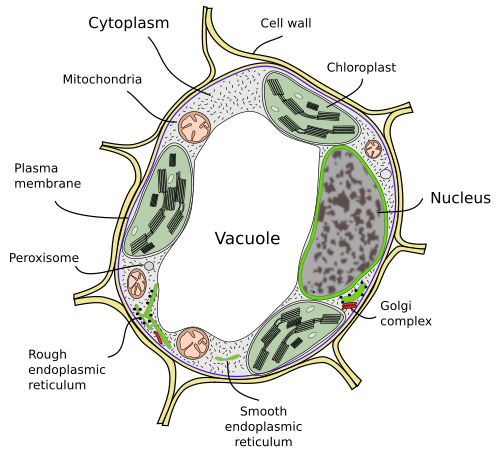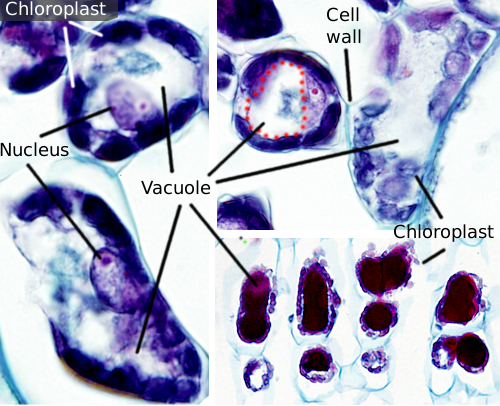1. Features
2. Functions
- Turgor
- Storage
- Lytic
- Apoptosis
- Others
3. Vesicular trafficking
Vacuoles are membrane-bound organelles found in plant cells and fungi, including yeasts. They are critical organelles for plant cell function: they maintain the cell size and morphology by turgor, store a diversity of substances, and are degradation centers.
1. Features
In mature cells, vacuoles are usually very large compartments that can make up to 90 % of the total cell volume (Figures 1 and 2). They are the largest organelles in plant cells. The name vacuole is derived from the Latin word "vacuus", which means empty. This was clearly a misunderstanding because vacuoles are filled with a more or less concentrated aqueous solution. The membrane of the vacuole is called tonoplast, and it is an essential part of the function of this organelle.


The shape of vacuoles is influenced by cell morphology and physiology. One large vacuole is often observed in mature plant cells, filling most of the cytoplasm with a large and unfolded membrane. However, the membrane of the vacuole sometimes gets deeply and profusely folded and forms small compartments, such as transvacuolar strands and bulbs. Transvacuolar strands are small ducts or channels that cross the vacuole and communicate two distant cytoplasmic regions, for example, the peripheral cytoplasm and the nuclear surroundings. Cytosolic content and some organelles like Golgi apparatus cisterns, mitochondria, chloroplasts and endosomes, may travel through these channels. They can also influence the nuclear position in the cell. The vacuolar strands are driven by actin filaments. The vacuolar bulbs are independent and rounded intravacuolar compartments of about 1 to 22 µm, consisting of a double limiting membrane enclosing cytoplasmic material. Some authors think that they may be artifacts.
New vacuoles are formed by the fusion of vesicles released from the trans domain of the Golgi apparatus. Initially, they form a new compartment known as pro-vacuole. A meristematic cell may have hundreds of pro-vacuoles. Then, during cell differentiation, pro-vacuoles fuse to one another into small vacuoles, and the fusion process continues until a large central vacuole is formed. The endoplasmic reticulum might be also involved in the formation and growth of vacuoles in some plant cells, mostly in seeds. Once a large vacuole is present, vesicles coming from the Golgi apparatus and plasma membrane regulate the vacuole size by adding and removing membrane.
There are several types of vacuoles according to their function. One cell may contain different types of vacuoles, and even one vacuole may change its molecular repertoire to develop a different function. There are two main types of vacuoles: those storing proteins and lytic vacuoles. The pH is acid in lytic vacuoles and neutral in storing vacuoles. Storing vacuoles are abundant in seeds, where they concentrate a large amount of proteins to be used during germination. Some anti-pathogen substances are found in storage vacuoles. Lytic vacuoles are found in most plant cells. That is why they are also known as vegetative vacuoles. They are large compartments filled with an acid solution containing salts (sodium, potassium), metabolites (carbohydrates, organic acids) and some pigments. Some of these molecules enter the vacuole from the cytosol against concentration gradient. The normal pH inside the vacuole ranges between 5 and 5.5, although it can be around 2 in the lemon fruit, or even 0.6 in some algae.
2. Function
Vacuoles are essential for the physiology and homeostasis of plant cells and perform different functions according to the cell type. They influence the cell size and shape by turgor, store nutrients (carbohydrates, metabolites, amino acids, enzymes, proteins, and anthocyanins), and also store toxic substances and molecules against pathogens and herbivores.
Turgor
Cell turgor is the level of hydrostatic pressure against the cell wall of a plant cell. This pressure is under the control of vacuoles, which get several substances inside, including ions, to produce different inner osmotic environments when compared with those of the cytosol. The different osmolarities at both sides of the vacuole membrane make the water cross the membrane, either inward or outward. The substances that contribute to the vacuole osmolarity can cross the vacuole membrane by ATP-dependent transport mediated by ion pumps. H(+)-ATPase and H(+)-pyrophosphatase are able to form proton gradients between both sides of the vacuole membrane, and these gradients are used to transport other molecules. The ability to store water inside the vacuole is essential for plant cells to grow after mitosis. Plant cells can increase their size 10 to 20 times, which is very useful for the body plant to grow plant organs. The growth mediated by hydrostatic pressure saves energy because it is cheaper to increase the amount of water than synthesize new molecules (animal cell growth is based on molecular synthesis). It is safer for plant cells to accumulate water in the vacuole because, in this way, the cytosol molecules do not get diluted, which would compromise cell survival.
Storage
Vacuoles are the last station for some vesicular trafficking pathways. In some cells, they are the organelle that store carbohydrates, organic acids and proteins. In the chlorenchyma (parenchyma involved in photosynthesis), such as the leaf mesophyll, vacuoles are transient stores of photosynthesized organic material that are later mobilized to other plant organs. In CAM plants, the malic acid is also temporarily stored in vacuoles during the night and released during the day. The storing function is clear in seeds, where vacuoles accumulate proteins needed for germination. Storage vacuoles become lytic vacuoles during cell differentiation.
Unlike animals, plants do not have an excretory system, and they cannot move to avoid toxic substances. In plants, potentially toxic substances are stored in vacuoles. In this way, metabolism residues and toxic substances like heavy metals (cadmium, zinc and nickel) and other molecules such as nicotine, alkaloids (opium), tannins and phenolic components are found in vacuoles. Some of them may be stored as long as the cell is alive. Some toxic substances for the plant are also toxic for herbivores, so they are a protection mechanism against animals. In addition, vacuoles may also store other substances such as pigments (for example, anthocyanins) in the epidermal cells of petals, resins, and so on. Most of the taste of fruits and vegetables is the result of substances stored in vacuoles.
Degradation centers
Lytic vacuoles, or vegetative vacuoles, can be found in vegetative tissues. They contain enzymes like proteases and nucleases, as well as a number of proteins involved in the defense against pathogens. Proton pumps inserted in the vacuole membrane enter protons into the lumen and acidify the content. The low pH and the lytic enzymes allow degradation processes. Vacuoles have a similar role to lysosomes in animal cells. For instance, vacuoles participate in autophagy by removing organelles. Vacuolar processing enzymes are proteins that transform molecular precursors arriving in the vacuole as inactive molecules into active molecules.
Apoptosis
Vacuoles are involved in plant cell apoptosis via a mechanism known as autolysis. In addition, a type of cell death known as hypersensitive cell death occurs in plant cells when the vacuole membrane is broken.
Others
There are specialized vacuoles found in different plant tissues. For instance, in the seed internal integuments, vacuoles accumulate flavonoids for protection against ultraviolet light, give color, and to decrease stress. Flavonoids are synthesized on the cytosolic surface of the endoplasmic reticulum membranes and then translocated to the interior of vacuoles for final chemical processing. In the vacuole membrane, there are transporters to carry out this translocation.
Some plant species, like brassicas, have vacuoles in their vegetative tissues to repel herbivores. These vacuoles store proteins, such as myrosinases. Once released by the herbivore activity, these enzymes degrade molecular compounds in the leaves that become toxic for the animal. Cells storing myrosinases are known as myrosine cells and can be found near the vascular bundles of leaves.
Plants lack an immune system, and each cell has its own defense system. Defense proteins and enzymes can be found in vacuoles. There are two defense mechanisms that vacuoles can perform (Figure 3). The vacuole membrane collapses and its content is released into the cytoplasm. Viral infections lead to vacuole membrane breakage and release enzymes into the cytosol, where they can attack viruses. Another mechanism is the fusion of the vacuole membrane with the plasma membrane, which leads to the release of vacuole enzymes into the extracellular space, where they can kill pathogens like bacteria.

3. Vesicular trafficking
Vacuoles are part of the vesicular trafficking. Actually, they may be regarded as an end-product of vesicular trafficking, since their formation and maintenance depend on the incoming vesicles. Molecules that are going to be stored or degraded, including hydrolytic enzymes and all membrane molecules, are targeted to vacuoles via vesicles. Molecules can follow different vesicular pathways to get to vacuoles.
Endoplasmic reticulum> Golgi apparatus> Vacuole; Golgi apparatus> pre-vacuolar compartment > vacuole. This is the default pathway to transport hydrolytic enzymes toward vacuoles. Pre-vacuolar compartments are similar to multivesicular bodies/ late endosomes in animal cells. Curiously, hydrolytic enzymes are not selected in the Golgi apparatus by 6-phosphate-mannose moieties, as happens in animal cells, but by a specific sequence of amino acids. All proteins targeted to vacuoles have a signal sequence, and they need to be specifically recognized by receptors. There are specific sequences for targeting proteins to the hydrolytic vacuoles and other sequences for the storing vacuoles.
Endoplasmic reticulum> vacuole. Molecules may get to vacuoles directly from the endoplasmic reticulum. This pathway is prominent in seeds as a pathway for storage. However, in other plant cells, as in leaves, this pathway might be very rare. Vesicles traveling from the endoplasmic reticulum to vacuoles are independent of COP-II coats, which are needed for vesicles targeted to the Golgi apparatus. In the endoplasmic reticulum-vacuole pathway, there are sometimes intermediate compartments, but they are transient membrane-bound organelles where molecules are briefly retained before they arrive at the vacuole. This vesicular pathway may be derived from autophagy-related cellular components.
-
Bibliography ↷
-
Bibliography
Marty F. 1999. Plant vacuoles. Plant cell 11:587-600.
Pereira C., Pereira S, Pissarra J. 2014. Delivering of proteins to the plant vacuole--an update. International journal of molecular sciences 15: 7611-762.
Shimada T, Takagi J, Ichino T, Shirakawa M, Hara-Nishimura I. 2018. Plant vacuole. Annual review in plant biology. https://doi.org/10.1146/annurev-arplant-042817-040508.
Taiz L. 1992. The plant vacuole. Journal of experimental biology 172: 113-122.
Zhang C, Hicks G R, Raikhel NV. 2014. Plant vacuole morphology and vacuolar trafficking. Frontiers in plant sciences 5: 476.
-
 In plant cells
In plant cells 